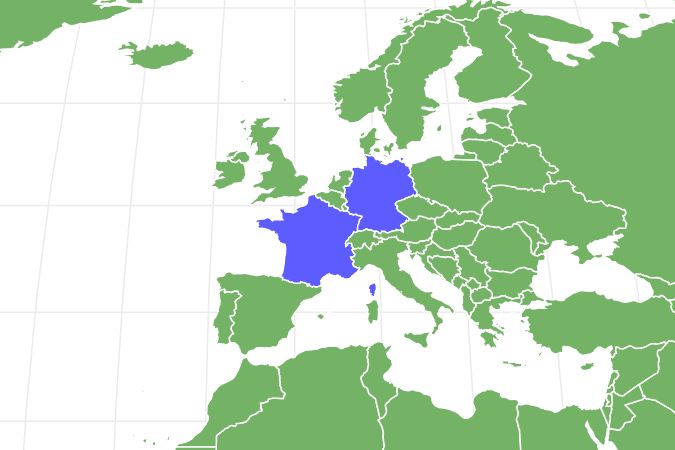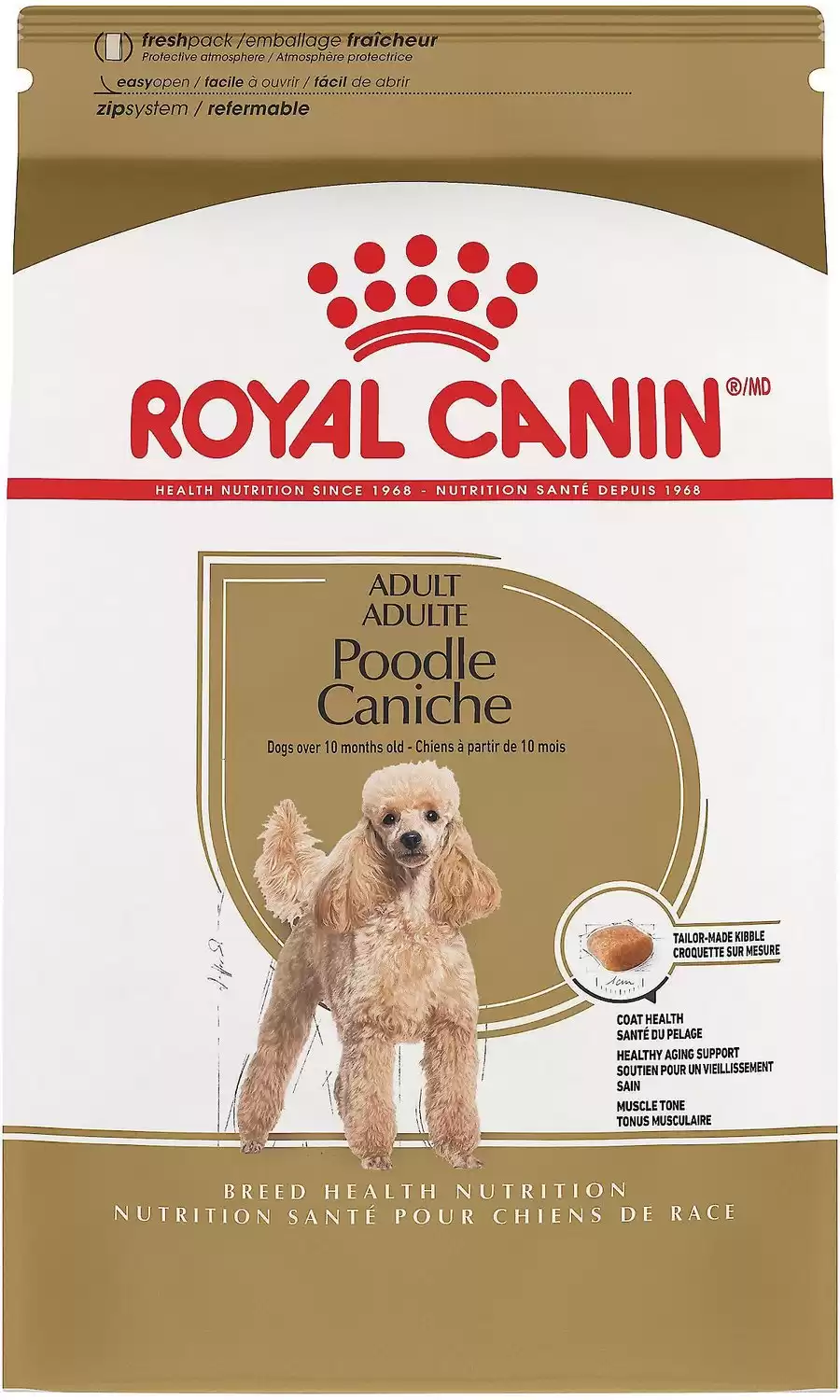Toy Poodle
Canis lupus
The word poodle is derived from German, and it means "to splash" or "puddle."
Advertisement
Toy Poodle Scientific Classification
- Kingdom
- Animalia
- Phylum
- Chordata
- Class
- Mammalia
- Order
- Carnivora
- Family
- Canidae
- Genus
- Canis
- Scientific Name
- Canis lupus
Read our Complete Guide to Classification of Animals.
Toy Poodle Conservation Status
Toy Poodle Facts
- Fun Fact
- The word poodle is derived from German, and it means "to splash" or "puddle."
- Temperament
- Intelligent, active, alert
- Diet
- Omnivore
Toy Poodle as a Pet:
- General Health
- Energy Level
- Shedability
- Trainability
- Intelligence
- Tendency to Chew
- Size
- Family and kid friendliness
- Yappiness / Barking
- Moderate
- Separation Anxiety
- High
- Preferred Temperature
- Average climate
- Exercise Needs
- Moderate
- Friendly With Other Dogs
- Moderate
- Pure bred cost to own
- $1,925
- Dog group
- Toy
- Male weight
- 3.5-5.5 lbs
- Female weight
- 3.3-5.5 lbs
This post may contain affiliate links to our partners like Chewy, Amazon, and others. Purchasing through these helps us further the A-Z Animals mission to educate about the world's species.
View all of the Toy Poodle images!
Toy poodles are one of the most popular dog breeds in the world! You may find yourself continually laughing at your dog because their agility and intelligence let them get in and out of some situations you’ll find hard to believe.
Most toy poodles are very self-confident. This breed is the smallest of the poodle breeds, and it was first bred in America as a companion animal for city-dwellers. This member of the Toy Group was bred down from the standard poodle that was first bred in Germany as a retrieving water dog more than 400 years ago. Agile, intelligent, and self-confident, this poodle may be the right breed for you.
See all of our expert product reviews.
If you want a dog that will miss you when you are gone, the toy poodle may be your perfect companion. Funny, intelligent, and cute, they are very loyal dogs that may make you the ideal pet.
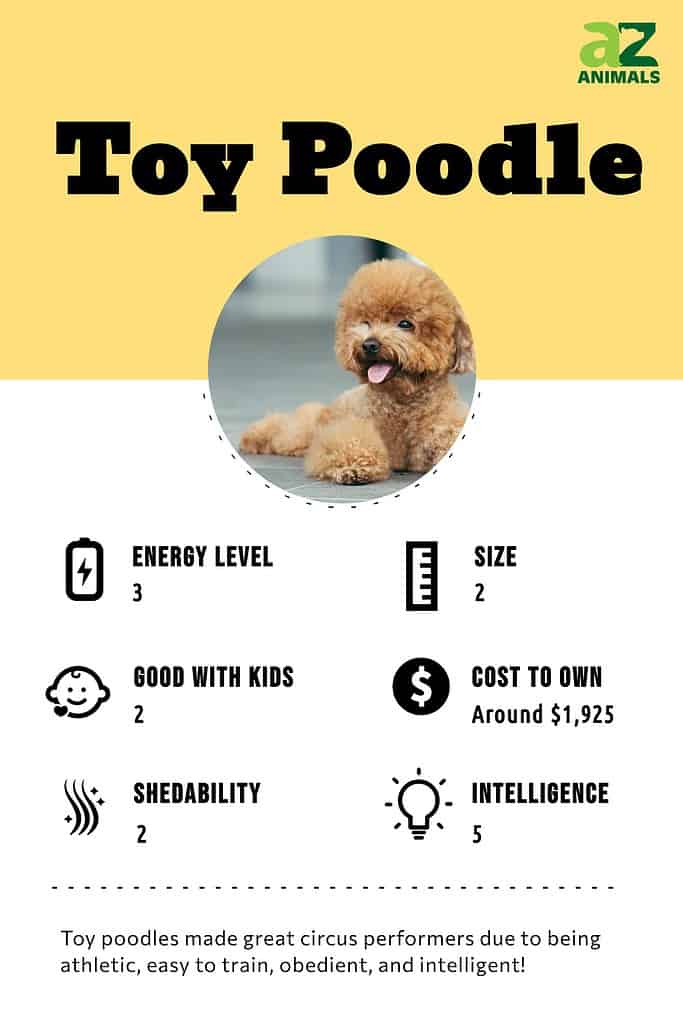
9 Different Types of Toy Poodles and Toy Poodle Mixes
The American Kennel Club officially recognizes only solid colors of these poodles. The dog can be lighter in some areas and darker in others, but it cannot be a mixture of more than one color. These colors include:
- Blues – These dogs look like they have faded black coats. They must have black noses, eye-rims and lips, black or self-colored toenails, and very dark eyes. These dogs are born black and change over before their second birthday.
- Grays – These dogs may be born with a gray coat, or they may develop it by the time they are five. They must have black noses, eye rims, and lips along with black or self-colored toenails and very dark eyes.
- Silvers – These dogs look like they are diluted gray, and they have dark points like blues and grays. Once the head starts to clear at about six weeks, the face and paws will be silver. The rest of the body will become silver over the next two years. These dogs have the silver allele V gene.
- Browns – Brown toy poodles are an intense brown. They are carriers of the BB gene. Brown toy poodles will have liver-colored noses, eye-rims and lips, dark toenails, and dark amber eyes.
- Café Au Laits – This color is a light tan. Dogs can either be born this color or develop it before they are two. They must have liver-colored noses, eye-rims and lips, dark toenails, and dark amber eyes.
- Apricots – There are different variations of this color. Some will look almost the color of hay, while others are so light that they might be confused with a Cream. Examine the skin under its coat, and it will have some black spots. Judges will give preference to dogs with dark-colored lips, toenails, and noses, but the amber color is not a disqualification.
- Creams – These dogs are carriers of the Cch gene, and they can be any shade of cream. They must have black noses, eye-rims and lips, black or self-colored toenails, and very dark eyes.
- Black – Black poodles will be black all over without a hint of another color. They must have black points.
- White – There is more variation allowed in white poodles than in other color groups as they can have an apricot or beige tint to their hair. They must have black noses, eye-rips and lips, very dark eyes, and black or self-colored toenails. One trait that is not allowed in this group are dogs with the ticking gene that makes their coat look dirty.
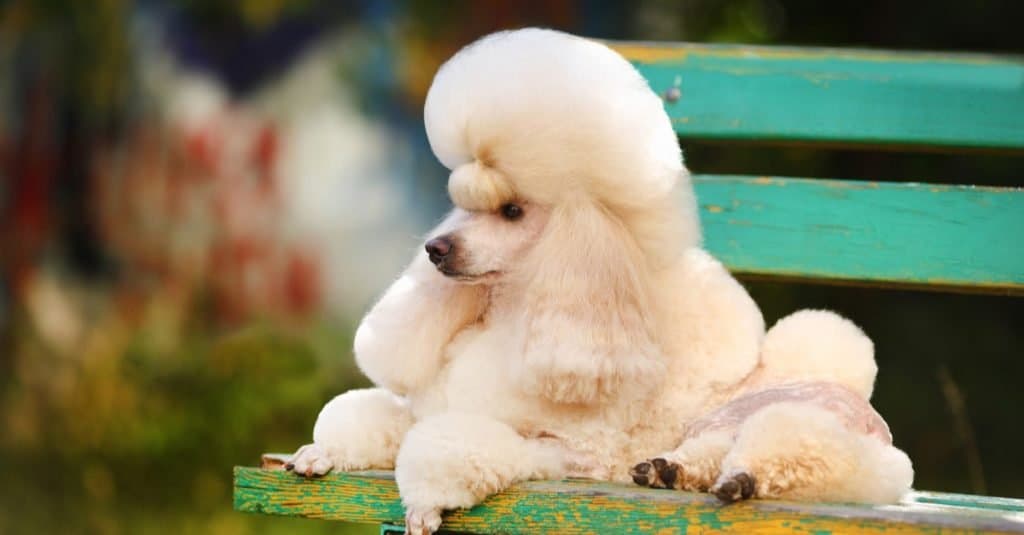
Apricot poodles can vary in color from looking like hay to being so light they are almost cream.
©Dulova Olga/Shutterstock.com
3 Pros and Cons of Owning Toy Poodles
| Pros! | Cons! |
|---|---|
| Light Shedders These poodles are one of the lightest-shedding coated breeds. | Frequent grooming required Toy poodles need to be groomed at least every six weeks. |
| Very athletic Toy poodles that have legs long enough so that their height is equal to their length are very athletic. | Need Constant Stimulation Toy poodles must be mentally stimulated, or they can become destructive. |
| Love routine These dogs love routines and constant companionship. | Hate chaos These poodles do not do well when there is too much chaos in a household. |
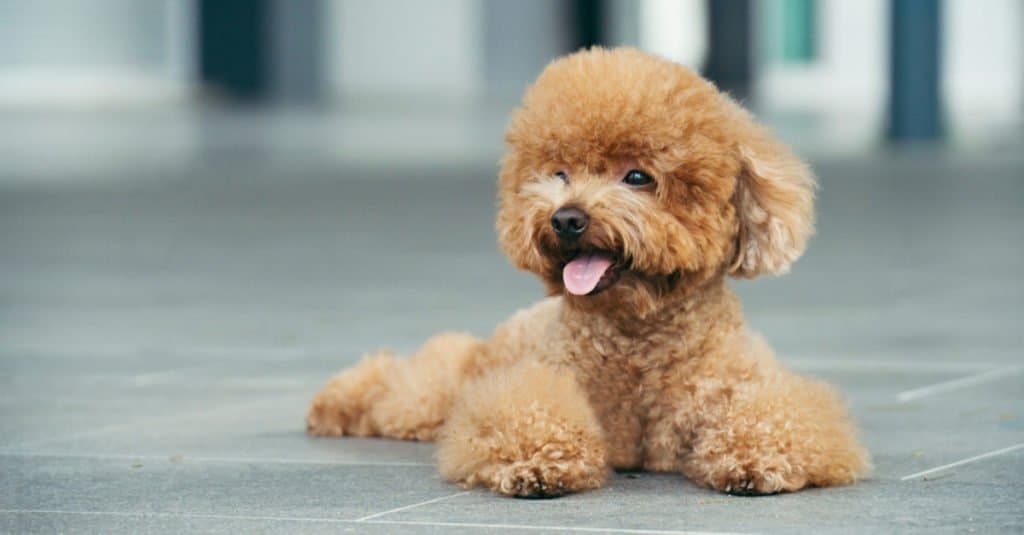
Toy poodles are one of the lightest shedding dog breeds.
Health and Entertainment for your Toy Poodle
See all of our expert product reviews.
©Lim Tiaw Leong/Shutterstock.com
Evolution and History
The toy poodle was bred to be a smaller version of the miniature poodle, which itself was developed from the standard poodle breed. It’s believed that many wanted smaller poodles as they appreciated the standard breed’s abilities but desired smaller-sized dogs. One such group was circus performers, who liked using the dogs in their acts due to their being easy to train, highly intelligent, obedient, athletic, and friendly but felt a smaller dog would make handling and transportation easier.
The standard poodle originated in the 1400s in Germany and its intelligence and gentle bite made it the perfect assistant to duck hunters. The hunters would shave the poodles’ coats to allow them greater range of movement while maintaining enough warmth and protection in their chests, hips, and legs when retrieving waterfowl, and these form the basis of the fancy clipping patterns seen on modern show dogs. The standard poodle later became popular among royalty and a favorite breed in France, being named in 1786 as France’s national dog. The miniature poodle was also originally bred for hunting, frequently used by truffle hunters.
It’s thought that toy poodles were first introduced around the 18th or 19th century. Initial efforts to create the smaller dogs met with difficulties both physical and behavioral as a result of irresponsible breeding, however once new practices were developed, the dogs became toy-sized replicas. They were originally primarily owned by royalty, who used them as lapdogs and warmers, being placed in the sleeves of clothing to provide warmth. King Louis XVI of France is known for being a huge fan of toy poodles.
The poodles in circuses performed tricks including walking tightropes, acting in comedic skits, and assisting in magic and card tricks. These days, poodles are famed as show dogs and are one of the most popular dog breeds on the planet.

Due to the toy poodle’s athleticism, obedience, and intelligence, they were popularly used in circus acts.
©Rin Seiko/Shutterstock.com
Size and Weight
To be classified as a toy poodle, the dog must be under 10 inches tall at the highest point of their shoulders (standard poodles are more than 15 inches tall at the shoulder, while miniature poodles are 15 inches or under). The dog’s length from the end of the rump to the breastbone should equal the height of the dog. While the American Kennel Club sets no minimum or maximum weight limits, most dogs and bitches weigh between 3.5-and-5.5 pounds. The smallest toy poodle born weighed less than 1 ounce and easily fit in a man’s hand.
| Height (Male) | Under 10 inches |
| Height (Female) | Under 10 inches |
| Weight (male) | Typically 3.5- 5.5 lbs |
| Weight (female) | Typically 3.5-5.5 lbs |
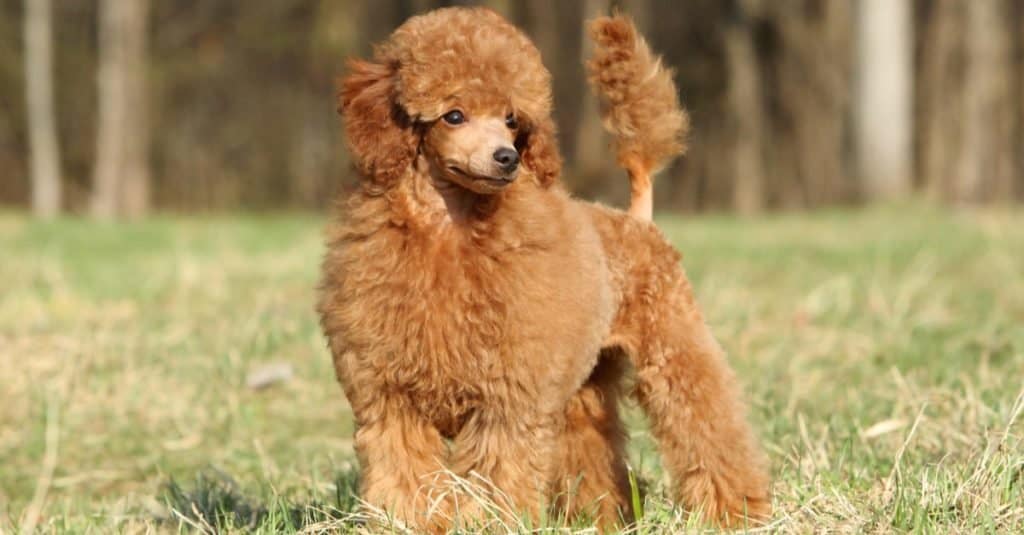
Poodles under 10 inches tall at the highest point of their shoulders are classified as toy poodles.
©Jagodka/Shutterstock.com
Common Health Issues
Like all dog breeds, these poodles have some common health issues. These include:
- Skin tumors
- Bladder stones
- Tracheal collapse
- Cushing’s disease
Let’s look at each in more detail.
Skin tumors often develop in dogs who are over seven years old. If they grow slowly and have a regular shape, they are usually nothing to worry about, but if they have an irregular shape and grow rapidly, then be sure to have your toy poodle checked out because it may be a cancerous growth.
The most common sign of bladder stones is blood in the urine and straining to urinate. While many stones take years to form, others form in as little as two weeks. Consult with a vet because this condition can be life-threatening and may require surgery.
Tracheal collapse occurs when the rings of cartilage that make up the tracheal collapse. Usually, doctors have a hard time determining the reason it starts. You may notice that the dog has a harsh dry cough. This condition typically occurs in middle-aged dogs and can make it hard to breathe and lead to respiratory issues.
Cushing’s disease, which is also called hyperadrenocorticism, is a malfunction of the adrenal glands. It usually develops very slowly. You may notice that the toy poodle drinks and urinates more than usual and eats more. Early treatment is usually an oral medication, but it can lead to hair loss, thin skin, and a potbelly if left untreated.
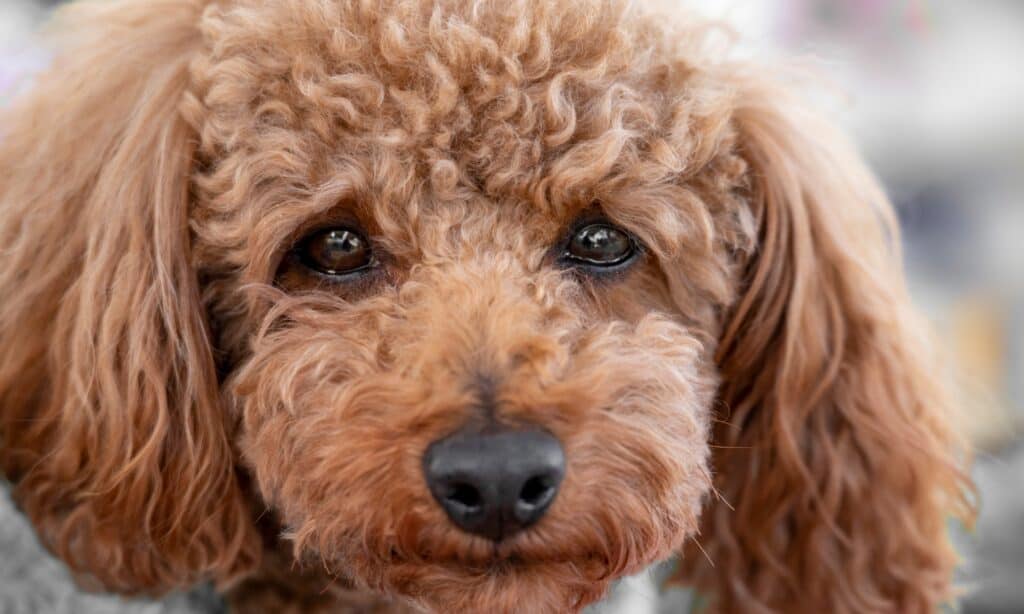
Common health problems that toy poodles face include skin tumors, bladder stones, and Cushing’s disease.
©iStock.com/TOSHIHARU ARAKAWA
Temperament
Many people are surprised by the poodle’s agility if they conform to the breed standard of being only as long as they are tall. This ability allows owners to train them for use in agility obstacle course competitions. This behavior often makes them fun to watch.
These poodles can be very protective. They tend to attach themselves to one person and want to be with them all the time. This trait can result in separation anxiety when that person is at work or does not take their dog with them. It can also lead to a toy poodle developing jealousy towards other dogs or people.
This breed thrives on routine. They are smart, and they like to know what is going to happen and when. If a pattern gets broken, one of their personality traits is that they become a little jittery, so if your home is not ordinarily quiet, this may not be the best breed for you. They tend to bark and can snap when they are startled.
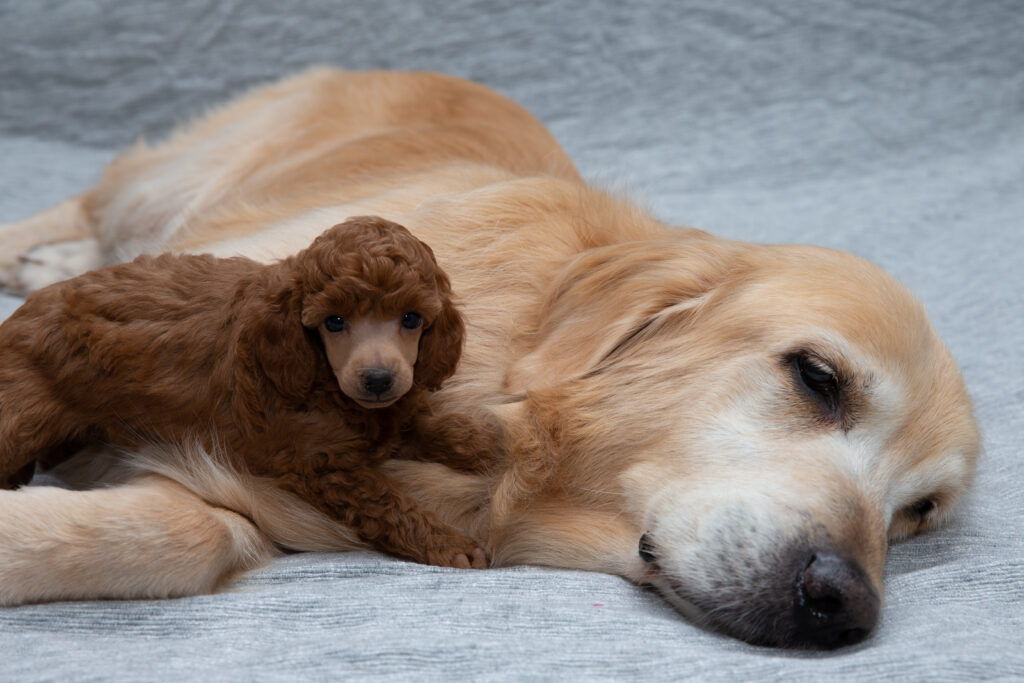
The toy poodle is a protective and loyal breed.
©Wirestock Creators/Shutterstock.com
How to Take Care of Toy Poodles
There are many factors to consider when taking care of a toy poodle, especially puppies. You need to be prepared to take care of your pet in the best way possible, so consider these various factors.
The Best Dog Food for Poodles
It is vital to consider the nutritional needs of your dog.
- Puppy food: During the first three months of a toy poodle puppy’s life, they should have food available whenever they want it. Be sure that you wash and dry their feeding bowl frequently. Beginning at three months, your toy poodle should be fed three times a day with healthy snacks in between meals. Puppies need about 45 calories per pound that they weigh daily.
- Adult food: Adult toy poodles should be fed at least two meals a day. Adult toy poodles need about 35 calories per pound that they weigh daily. You should feed them dry food because it is better for their gums.
This breed has unique health conditions, and you want the best for your poodle. So mindfully select a quality dog food that provides the nutrients they need to live a long, healthy life.
At A-Z Animals, we believe the best dog food for poodles is Royal Canin Breed Health Nutrition Poodle Adult Dry Dog Food.
Poodles and their owners can breathe a sigh of relief that Royal Canin makes a breed-specific dog food just for poodles and their individual needs, including their skin. Though joint issues in this breed aren’t prevalent, we’re glad this food includes calcium and glucosamine for improved cartilage that may help prevent tracheal collapse. There are only high-quality ingredients, so you may minimize your Poodle’s risk of adrenal problems.
Here’s where to find Royal Canin Poodle Dog Food on Chewy and Amazon.
- Contains EPA and DHA fatty acids
- Specially formulated for Poodles
- Shape of kibble makes it easy to pick up
- Antioxidants support healthy aging
Maintenance and Grooming
The great news is that toy poodles shed very little, but you will still need to brush the dog daily and groom it every eight weeks. Showers select a variation of the lion trim for show arenas, but many people choose to clip their toy poodle’s hair short all over if they are not showing them. When showing, the only artificial product that can be left on the dogs is an elastic band for their top cap. The first toy poodles were shown with corded coats, but this stopped being in vogue by the early 1930s.
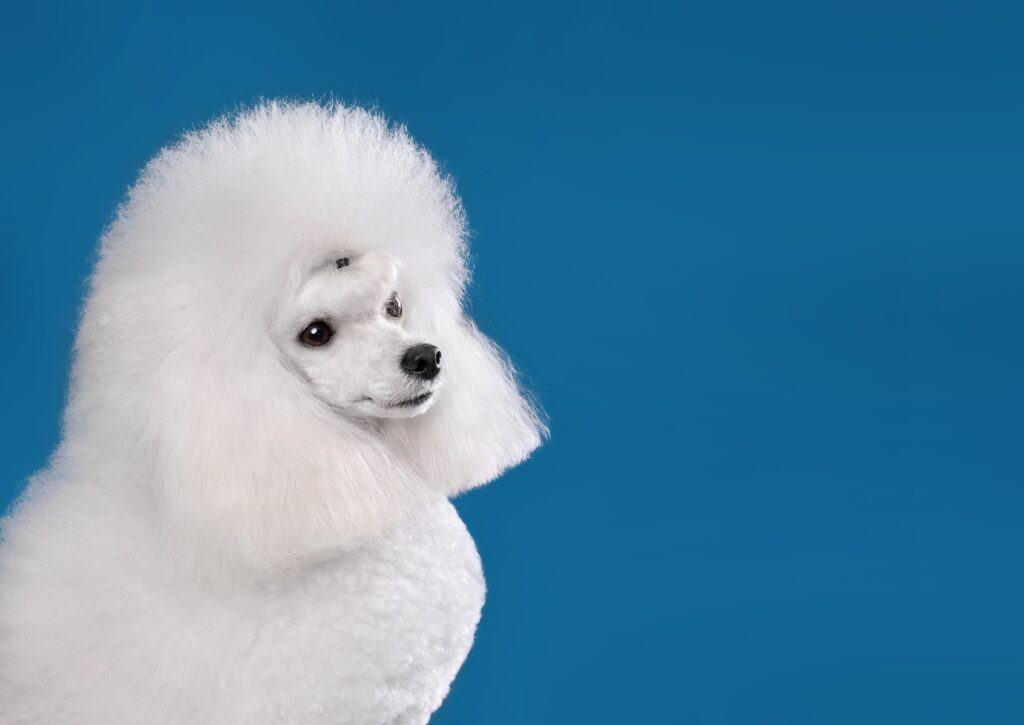
When showing, the only non-natural product that can be on the toy poodle is an elastic band for its top cap.
©eAlisa/Shutterstock.com
Training
Toy poodles are brilliant dogs, so it usually does not take them long to learn something new. Most experts list poodles and border collies and German shepherd dogs as the smartest in the world.
Exercise
A toy poodle needs 60 to 90 minutes of exercise daily. It requires a brisk walk. It also needs some form of exercise that is mentally stimulating. Generally, the walk should last about 20 minutes and cover about 0.75 miles. Many poodles love to go swimming.
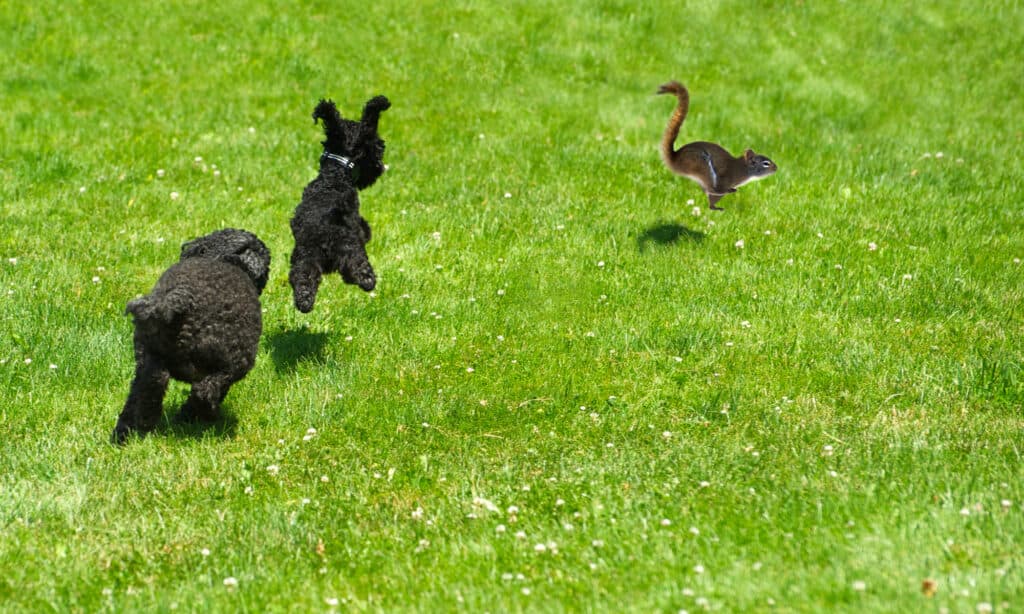
Toy poodles need regular exercise that is mentally stimulating.
©KellyNelson/Shutterstock.com
Puppies
Toy poodle puppies need good quality dog food three times a day. You need to groom puppies of this breed daily to get used to how it feels while they are young. Most toy poodles potty train very quickly. Make sure that you give them something to do, or they may chew up things you value.
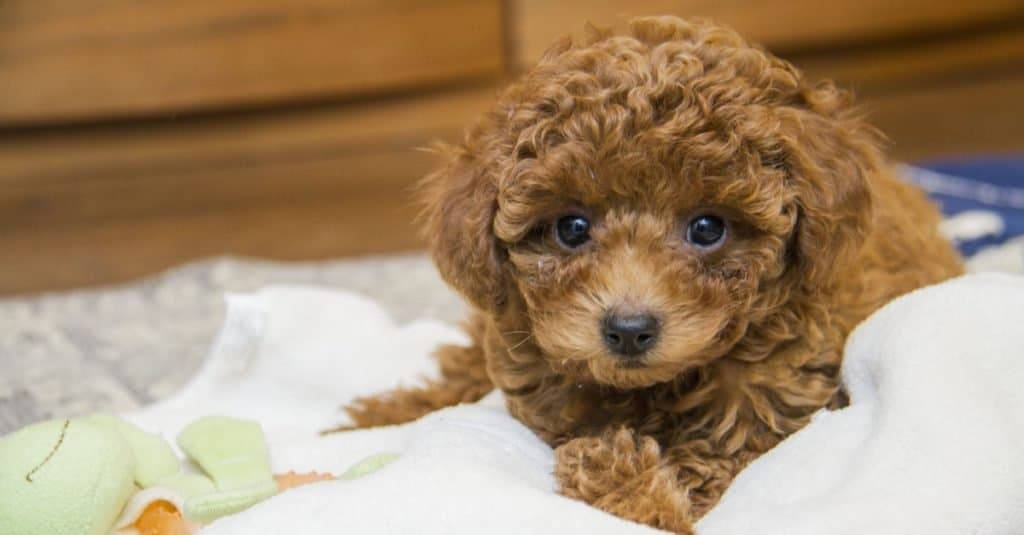
©Aarontphotography/Shutterstock.com
Toy Poodles And Children
Toy poodles can live with well-behaved children, but they generally prefer a quiet environment. They thrive on routine, so try to keep things the same every day. If you have children who come to visit occasionally, spend time interacting with them and your dog so that both know your boundaries. It is often easier to introduce a puppy to children than a full-grown dog.

Toy poodles typically prefer a quiet environment and routine.
©Jagodka/Shutterstock.com
Dogs Similar to Toy Poodles
Other dog breeds similar to the toy poodle include the cockapoo, Maltipoo, and peekapoo.
- Cockapoos – This is a cross between a toy poodle and a cocker spaniel. While staying about the toy poodle’s size when fully grown, most have a very gentle spirit, which may make them better family dogs.
- Maltipoo – This is a cross between a toy poodle and a Maltese. They tend to be up to five pounds heavier and five inches taller. They need to be brushed daily because of their wavy hair that curls.
- Peekapoo – This is a mix between a toy poodle and a Pekingese. They tend to be about an inch shorter, but they are stockier.
The price that you pay is often higher for a puppy than for a full-grown dog. Additionally, the price for designer dogs is often higher.
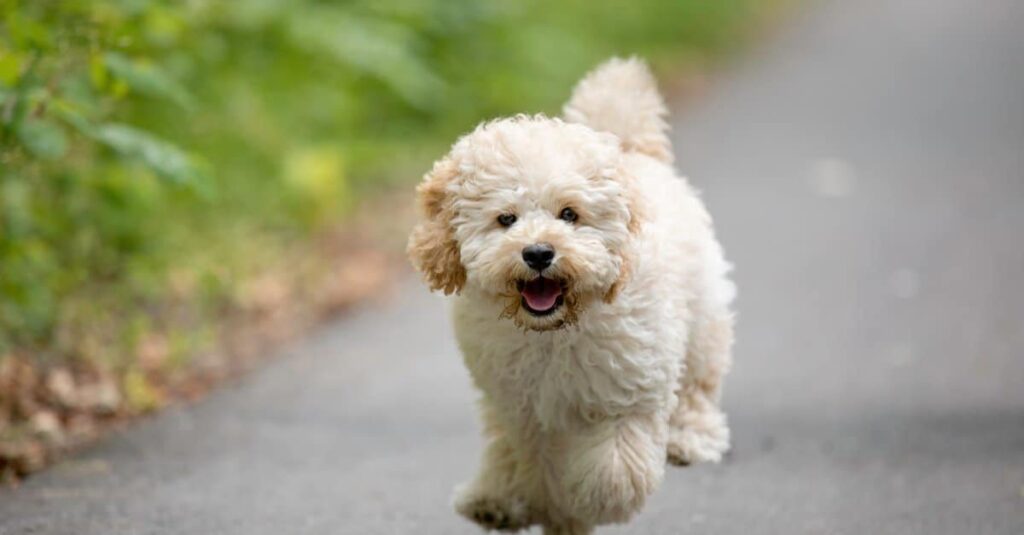
Maltipoos are a cross between a toy poodle and a Maltese and are heavier and taller than toy poodles.
©Rita Petcu/Shutterstock.com
Popular Names for Toy Poodles
Popular names for these poodles often include:
- Teddy
- Ivan
- Curly
- Molly
- Porter
- Red
Toy Poodle FAQs (Frequently Asked Questions)
What is a toy poodle?
A toy poodle is the smallest of the three breeds of poodles recognized by the American Kennel Club. It stands under 10 inches tall at the shoulders and weighs less than 10 pounds.
How do you groom a toy poodle?
There are several ways to groom a toy poodle. In the show arena, they are usually given a lion trim, but many people choose to clip their hair so it is short all over. This is often the way that rescues trim their dogs. Still, others decide to cord the hair.
How big is a toy poodle?
A toy poodle stands less than 10 inches tall at the shoulders. It weighs less than 10 pounds.
Do toy poodles bark a lot?
If the toy poodle, even a red or white one, is barking a lot, then take a look at the environment. As a breed, they do not like chaos and will often bark when it is happening. These poodles will also bark when they see or hear something unusual.
How much does toy poodle cost?
The median price of a toy poodle is $1,925. Consider checking rescues if you want an excellent toy poodle at a lower cost.
How much does a toy poodle cost to own?
In addition to the purchase price of about $1,925, you can expect to spend about $160 per month. Therefore, the first year of ownership may cost you $3,845. Additionally, you can expect to pay about $1,900 every year after the first one. Be sure that you can afford one without going into the red before getting one for your family. While getting one from a rescue can lower the initial investment, you still need to pay to have your dog taken care of properly.
Is a toy poodle good with kids?
Toy poodles tend to attach themselves to one individual, so they may not be the best choice for families. Additionally, their small size may mean children can injure them easily.
How long do toy poodles live?
The lifespan of a toy poodle is 12 to 16 years. You need to be prepared to take care of them for their entire lifespan. Even as a puppy, they tend to get attached and have a hard time moving to a new owner during their lifespan.
What's the difference between toy poodles, miniature poodles, and teacup poodles?
The primary difference between these three poodles is their size. Their lifespans also differ, but miniature poodles are the largest, followed by toy poodles, and finally teacup poodles.
Thank you for reading! Have some feedback for us? Contact the AZ Animals editorial team.
Sources
- Next Day Pets, Available here: https://www.nextdaypets.com/Poodle-Toy.htm#:~:text=You%20should%20expect%20to%20pay,Toy%20Poodles%20sold%20is%20%241%2C200.
- American Kennel Club, Available here: https://www.akc.org/dog-breeds/poodle-toy/
- The Spruce Pets, Available here: https://www.thesprucepets.com/toy-poodle-dog-breed-profile-4783452
- Bakercise, Available here: https://barkercise.com/exercise-poodle-toy-mini-standard/#:~:text=older%20dogs%20body.-,In%20Summary,some%20purposeful%20activity%20and%20play.
- All Poodle Info, Available here: http://www.allpoodleinfo.com/poodle-colors
- Pet MD, Available here: https://www.petmd.com/dog/breeds/c_dg_toy_poodle

